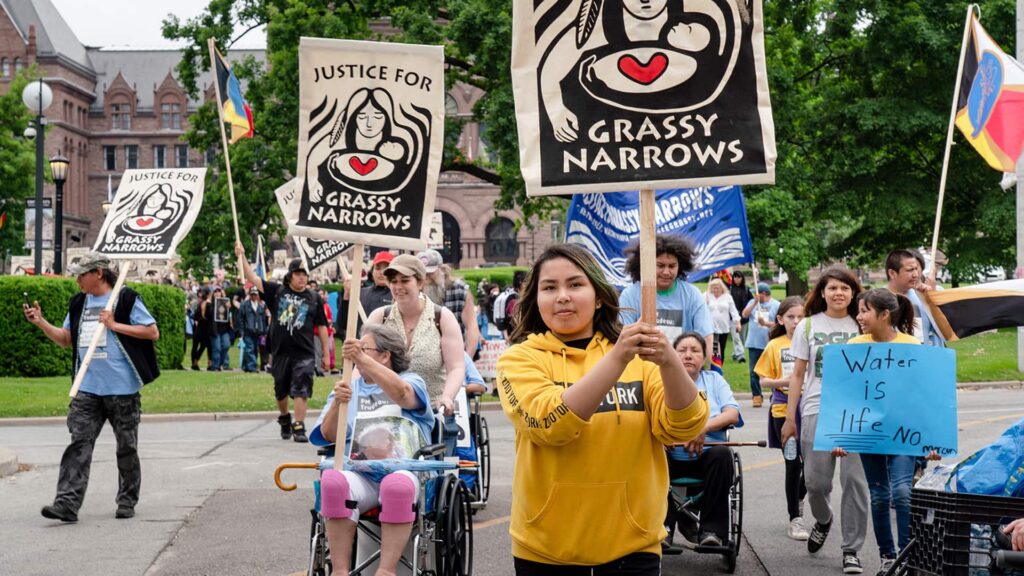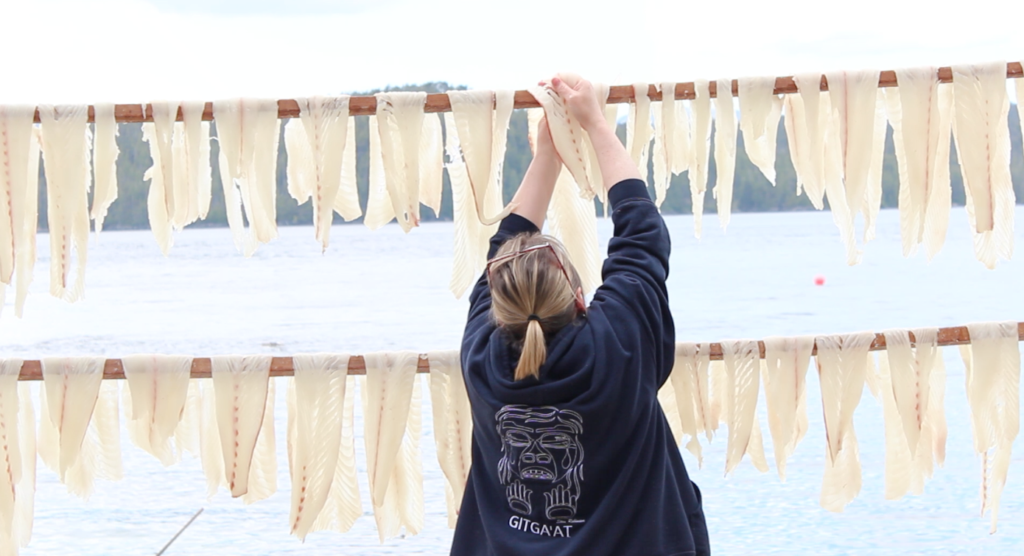Chapter 1: Introduction to Environmental Issues
1.5 Environmental Justice & Indigenous Rights
Environmental Justice

Environmental Justice is defined as the fair treatment and meaningful involvement of all people regardless of race, color, national origin, or income with respect to the development, implementation, and enforcement of environmental laws, regulations, and policies. It will be achieved when everyone enjoys the same degree of protection from environmental and health hazards and equal access to the decision-making process to have a healthy environment in which to live, learn, and work.
Whenever a community is faced with the potential of an environmentally undesirable facility, such as the placement of a hazardous waste dump in its midst, the usual response from residents is: “Not in my back yard!” Such a response is known as the NIMBY principle. Such reactions are usually reactions to visions of previous environmental irresponsibility: uncontrolled dumping of noxious industrial wastes and rusty steel drums oozing hazardous chemicals into the environment. Such occurrences were all too real in the past and some are still taking place. It is now possible – and much more common – to build environmentally sound, state-of-the-art disposal facilities. However, the NIMBY principle usually prevents the construction of such new facilities. Instead, hazardous waste facilities tend to be built upon pre-existing, already contaminated sites, even though the geology of such locations may be less favorable for containment than potential new sites.
Environmental Racism
During the 1980’s minority groups protested that hazardous waste sites were preferentially sited in minority neighborhoods. Dr. Benjamin Franklin Chavis, the Executive Director of the United Church of Christ is credited with coining the term environmental racism, and in 1987, his church’s Commission for Racial Justice released a landmark report titled, “Toxic Wastes and Race in the United States: A national report on the racial socio-economic characteristics of communities with hazardous waste sites.” Among its findings, the report found that “Race proved to be the most significant among variables tested in association with the location of commercial hazardous waste facilities,” representing a consistent national pattern. More recently, peer-reviewed research by the EPA’s National Center for Public Health has confirmed a similar pattern, finding that disparities in the distribution of air pollution sources for particulate matter are more pronounced based on race (particularly for African Americans) than they are based on poverty status.
While there are fewer and less well developed studies documenting environmental racism in Canada, there is ample evidence that similar patterns apply. Mitchell and D’Onofrio note that “Numerous Aboriginal communities, including Aamjiwnaang First Nation and Grassy Narrows First Nation in Ontario, Fort Chipewyan in Alberta, and Mi’kmaw communities in Nova Scotia, have expressed concerns with regard to contamination of their air, water, and soil, and have reported high rates of cancer and other illnesses in their communities.” (p. 322). Additionally, the ENRICH project in Nova Scotia has mapped what the group views as incidents of environmental racism in that province. The siting of hazardous waste facilities and other sources of pollution in Canadian communities certainly appears to be disproportionately linked to race and poverty levels.
In an ideal world, there would be no hazardous waste facilities or industrial sources of pollution. Unfortunately, we live in a world plagued by years of rampant pollution and hazardous waste dumping. Our industrialized society produces wastes during the manufacture of products for our needs (and wants). Until technology can find a way to manage (or eliminate) hazardous waste, disposal facilities will be necessary to protect both humans and the environment. By the same token, this problem must be addressed. Industry and society must become more sensitive in the selection of future hazardous waste and pollution sites, and all humans who help produce hazardous wastes must share the burden of dealing with those wastes. Extended producer responsibility and take-back programs are one potential solution, as are cradle-to-cradle design processes that ensure products can be fully recycled or reused at the end of their useful lives.
Indigenous Rights
Since the end of the 15th century, most of the world has been claimed and colonized by established nations. Invariably, these conquered lands were home to peoples indigenous to those regions. Some were wiped out or assimilated by the invaders, while others survived while trying to maintain their unique cultures and way of life. The United Nations officially classifies Indigenous people as those “having an historical continuity with pre-invasion and pre-colonial societies,” and “consider themselves distinct from other sectors of the societies now prevailing in those territories or parts of them.” Furthermore, Indigenous people are “determined to preserve, develop and transmit to future generations, their ancestral territories, and their ethnic identity, as the basis of their continued existence as peoples in accordance with their own cultural patterns, social institutions and legal systems.” A few of the many groups of Indigenous people around the world are: the 634 Indigenous communities in Canada, speaking more than 50 distinct languages; the Aboriginal and Torres Strait Islander people of Australia, the Māori people of New Zealand, Indigenous peoples of the rainforest in Brazil, and the Ainu of northern Japan.
Many problems face Indigenous people, including lack of human rights, exploitation of their traditional lands and themselves, and degradation of their culture. In response to the problems faced by these people, the United Nations proclaimed an “International Decade of the World’s Indigenous People” beginning in 1994. The main objective of this proclamation, according to the United Nations, was “the strengthening of international cooperation for the solution of problems faced by indigenous people in such areas as human rights, the environment, development, health, culture and education.” Its major goal was to protect the rights of indigenous people. Such protection would enable them to retain their cultural identity, such as their language and social customs, while participating in the political, economic and social activities of the region in which they reside.
Despite the U.N. goals, the rights and feelings of Indigenous people are often ignored or minimized, even by supposedly culturally sensitive developed countries. In Canada, both the federal government, and the provincial government of Alberta, have pushed to rapidly exploit the oil sands of that province, including the construction of pipelines through British Columbia to carry crude oil to the coast for export by tanker. Many Indigenous communities along the pipeline routes fear the risk of oil spills in their territories, which could wipe-out their traditional way of life. For example, the Gitg’at First Nation relies on a healthy marine environment for sustenance, sourcing 40% or more of their meals from the ocean, with foods like halibut, crab, salmon, prawns, mussels, clams, seaweed, oysters and herring.

The heart of most environmental conflicts faced by governments usually involves what constitutes proper and sustainable levels of development. For many Indigenous peoples, sustainable development constitutes an integrated wholeness, where no single action is separate from others. They believe that sustainable development requires the maintenance and continuity of life, from generation to generation and that humans are not isolated entities, but are part of larger communities, which include the seas, rivers, mountains, trees, fish, animals and ancestral spirits. These, along with the sun, moon and cosmos, constitute a whole. From the point of view of Indigenous people, sustainable development is a process that must integrate spiritual, cultural, economic, social, political, territorial and philosophical ideals.
Attribution
Essentials of Environmental Science by Kamala Doršner is licensed under CC BY 4.0. Modified from original.
Mikati, I., Benson, A. F., Luben, T. J., Sacks, J. D., & Richmond-Bryant, J. (2018). Disparities in Distribution of Particulate Matter Emission Sources by Race and Poverty Status. American Journal of Public Health, 108(4), 480–485. https://doi-org.ezproxy.kpu.ca:2443/10.2105/AJPH.2017.304297
Mitchell, K., & D’Onofrio, Z. (2016). Environmental injustice and racism in Canada: The first step is admitting we have a problem. Journal of Environmental Law and Practice, 29, 305-345. Retrieved from https://ezproxy.kpu.ca:2443/login?url=https://search-proquest-com.ezproxy.kpu.ca:2443/docview/1771698573?accountid=35875

